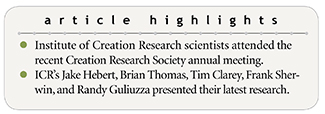 Scientists from the Institute for Creation Research presented their current research at the Creation Research Society’s annual meeting in late July. About 150 people attended the two-day conference held at Concordia University in Mequon, Wisconsin.
Scientists from the Institute for Creation Research presented their current research at the Creation Research Society’s annual meeting in late July. About 150 people attended the two-day conference held at Concordia University in Mequon, Wisconsin.
Dr. Jake Hebert presented results from two Creation Research Society Quarterly papers he co-authored with ICR’s Dr. Jim Johnson. He discussed possible scriptural clues regarding the structure of the universe that may have been overlooked by creationist researchers. These clues might enable us to draw inferences that could help nail down details of a biblical cosmology.
Dr. Hebert also addressed the common creation question “Where are the human Flood fossils?” Reports of “out of place” human fossils were common in the 1800s and early 1900s. Today, these are controversial, even among creationists. Some creationists argue that even if they’re genuine, the fossils are likely the remains of people who lived after the Flood and are therefore of little interest to creation researchers. However, given the strong evidence—some compiled by ICR’s Tim Clarey—that nearly all the world’s sedimentary rocks date from the Flood year, many of these fossils could very well be the remains of people who perished during the Flood. Although caution is warranted, perhaps it’s time for creation researchers to take a second look at them.
Dr. Brian Thomas presented his research on collagen in human and dinosaur bone. The SHG imaging technique he used requires no sample treatment and directly detects collagen. Modern, medieval, Ice Age, Cretaceous, and Jurassic bone samples were tested. Collagen was firmly detected in the first two categories and less firmly detected in the last three. Subject to verification using an independent technique, the identification of faint, microscopic traces of short-lived collagen in dinosaur bone challenges deep time.
Dr. Tim Clarey gave a presentation on Europe’s stratigraphic record. His talk served as an update of ICR’s Column Project. He noted that Europe shows many of the flooding patterns other continents have already revealed. The strata show minimal flooding occurred during deposition of the earliest megasequences. Later megasequences showed a steady increase in extent and volume as floodwaters rose higher. Dr. Clarey further demonstrated that deposition of marine sediments like limestone continued well into the Upper Cenozoic across much of Europe and even completely surrounded Turkey. This shows that the Flood was not over until after deposition of the Tejas Megasequence, corresponding to the Cenozoic strata in the geologic column.
Frank Sherwin presented non-evolutionary conjectures regarding the transition of some animals to modern parasitic creatures. The question was asked, “Could post-Fall parasites be slight genetic variations of non-parasitic pre-Fall ancestors?” Prior to the Fall and subsequent Curse, God saw that everything was “good” or “very good” (Genesis 1). Animals that later became parasitic may have first beneficially associated (mutualism or commensalism) with humans and animals. Others might have been free-living and not associated with other creatures. Clear answers are elusive regarding the parasitology part of the “predator/prey problem” in creation science.
Dr. Randy Guliuzza continued development of the continuous environmental tracking (CET) model, ICR’s engineering-based, organism-focused framework of biological adaptation. He presented additional evidence that organisms purposefully track environmental changes to deploy appropriate adaptive responses using the same engineering principles that underlie human-engineered tracking systems. CET expects a tight correlation between the elements in human-designed systems with those in biological systems that perform similar functions.
Dr. Guliuzza discussed examples of complicated built-in “anticipatory systems” creatures use to forecast future environmental conditions in their lifetime or their offspring’s. These innate logic-based systems give organisms foresight—both conscious and unconscious—of how they should preemptively self-adjust to predicted conditions. This implies that some biological adaptations are not purely reactive. Little is known about how biological anticipatory systems work, and Dr. Guliuzza explained how the CET framework could guide research by predicting system elements that might be discovered.
* Dr. Clarey is Research Associate at the Institute for Creation Research and earned his Ph.D. in geology from Western Michigan University.












